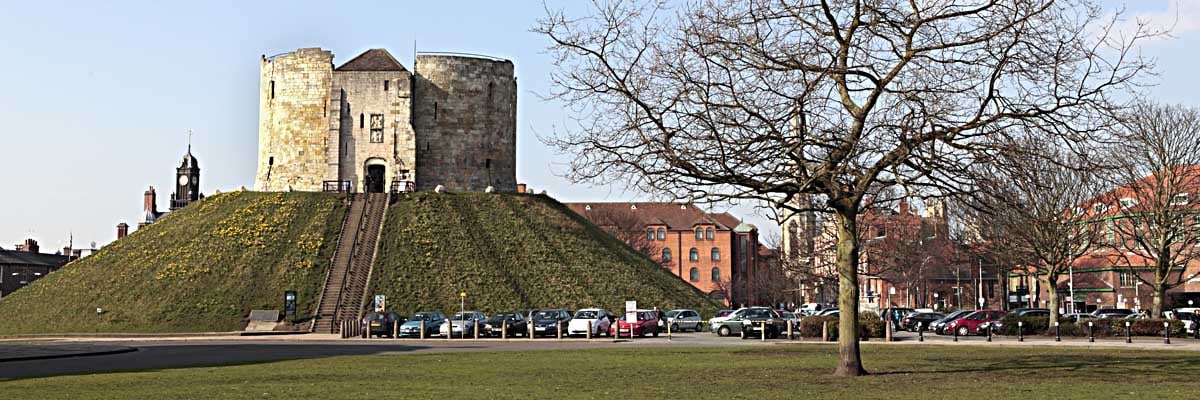Significance of Clifford’s Tower
Clifford's Tower is the most substantial survival of the large medieval castle of York, an important centre for the royal government of the north of England. Its architecture, though fragmentary, is of the highest quality. The site is of great historical importance for a well-documented massacre of the Jewish population of York in 1190.

York Castle in History
Clifford's Tower is the largest and most visible survival of the medieval castle of York. Remains of the curtain wall and several mural towers may also be seen along the southern parts of the site.
The castle seems to have been used more for coercive functions than as a royal residence – the king was generally lodged at the archbishop's palace.[1] It played an especially important role in the government of the north of England, housing a gaol, a mint and law courts.[2] Indeed, during episodes of intense Anglo-Scottish warfare other functions of central government, such as the Exchequer, were temporarily housed here and the tower was pressed into service as a treasury.[3]
Until the 19th century the area of the former castle bailey, immediately south-east of the tower, hosted elections and public proclamations. It is known as the 'Eye of York' or 'Eye of the Ridings' and retains its symbolic importance as a central place in the county.[4]
The mass suicide and massacre of the Jews of York in 1190, almost certainly in a predecessor of Clifford's Tower, is one of the most notorious events in medieval English history. Indeed, the events are of major significance for Jewish history as a whole. They are described in detail by numerous chroniclers and in administrative documents.[5]
City Defences
The tower formed part of the defences of York, which consisted of an almost-complete circuit of stone walls with impressive bars (gates), numerous mural towers, an adjacent fortification around the precinct of St Mary's Abbey and a second castle on Baile Hill, on the opposite bank of the Ouse.[6] The ensemble represents an internationally significant and outstandingly well-preserved example of medieval urban fortification.[7]
The Tower’s Design
The tower's design with four lobes is very unusual and no exact prototypes or derivatives are known in England. Pontefract, Dudley and Stafford castles are loosely comparable.[8]
As has long been recognised, however, the plan of Clifford's Tower is closest to that of the 12th-century Tour Guinette at Étampes in France (Seine et Oise). The towers bear a striking resemblance to each other in general form and key dimensions, and a connection between them is beyond doubt.
In other aspects, however, they differ in many ways. The Tour Guinette is thick-walled and tall, built of stone and standing on bedrock, whereas Clifford's Tower is a much slighter, lower building standing on an artificial mound.[9]
Even in its ruined state, the stone structure of Clifford's Tower represents an unusually good survival of a royal building from the reigns of Henry III and Edward I.
Landmark and Viewpoint
The view of Clifford's Tower on its mound is a highly prized and widely recognised vista of York. The tower still provides a magnificent viewpoint overlooking the historic city centre.
Footnotes
1. The National Archives (TNA), E 101/501/8.
2. The prison did not close until September 1929 and the assize courts still function as a magistrate's court.
3. TNA, E 159/71 rot 114d; for details of the fittings of the Exchequer of Receipt, presumably inside Clifford's Tower, see C Johnson and H Jenkinson, English Court Hand, vol 1 (London, 1915), 181–4 (accessed 29 October 2014).
4. Royal Commission on the Historical Monuments of England, Inventory of the Historical Monuments in the City of York, vol 2: The Defences (London, 1972), 65 (accessed 29 October 2014).
5. RB Dobson, The Jews of Medieval York and the Massacre of 1190 (York, 1974; rev edn 1996).
6. PV Addyman and J Priestley, 'Five castle excavations: reports on the Institute's research into the origins of the castle in England. Baile Hill, York: a report on the Institute's excavations', Archaeological Journal, 134 (1977), 115–56.
7. RCHME, op cit, passim.
8. M Hislop, 'A missing link: a reappraisal of the date, architectural context and significance of the Great Tower of Dudley Castle', Antiquaries Journal, 90 (2010), 211–33 (subscription required; accessed 29 October 2014).
9. TP Cooper, The History of the Castle of York (London, 1911), 40 (accessed 29 October 2014).